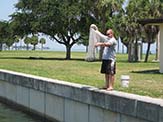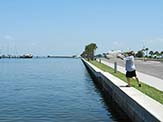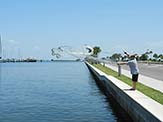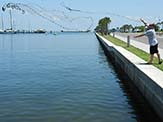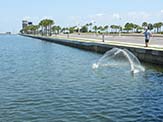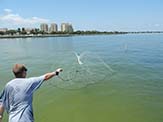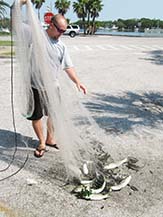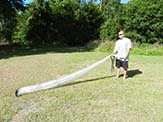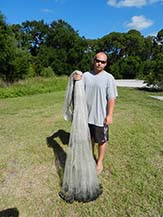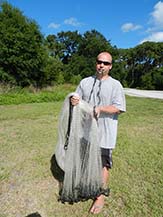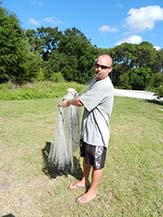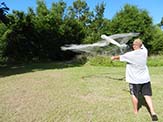Meats and Sausages
Cast Net
A cast net is a circular shaped mesh net with weights evenly distributed along its outer perimeter. When the net is thrown or "cast" it opens out and lands over the fish trapping them underneath. It looks like a parachute or the top of an umbrella falling down.
"Casting a net is not fishing, it is an art."
Adam Marianski casting net:
Cast nets have been around forever. There have been many advancements made to cast nets throughout history. Early cast nets were nothing more than a circular net with weights attached around the perimeter. Once thrown, a fisherman would have to find the net and carefully remove the fish one by one. Fortunately the modern day cast net has a hand line which allows the fisherman to pull the net to him. This advancement allows the fisherman to throw in much deeper water while ensuring he will not lose fish once they are caught.
There are various styles and sizes of cast nets that can be used but all modern cast nets are composed of the following parts:
- Hand line - a braided polyethylene line, floats in the water, has a loop on the end that attaches to the thrower's wrist.
- Brail lines - monofilament lines that connect the hand line to the lead line (perimeter of the net). The connection is made by means of a swivel which prevents any entanglement of brail lines with the hand line. These brail lines go through a center ring or "horn" and attach in designated places to the lead line.
- Horn - plastic ring where the net is attached to, the horn allows the brail lines to pass through and connect (through the swivel) to the hand line enabling a thrower to open and close the net.
- Lead line - braided polyethylene line that is the perimeter of the net when open. The weights or leads are attached and evenly spaced on the lead line. The lead line can be considered the outer perimeter of the cast net.
- Mesh size - monofilament line intertwined to make even openings that are consistent throughout the net.

When the net is cast the weighted lead line pulls the brail lines through the center of the horn to the bottom.
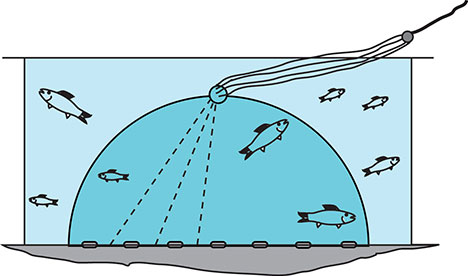
To retrieve the net and the fish, the thrower pulls out the hand line. The hand line pulls the brail lines up and closes the outer perimeter of the net. This creates a round bag which holds the fish. Once when the entire hand line is retrieved, the thrower grabs the brail lines and pulls them and the net closed up.
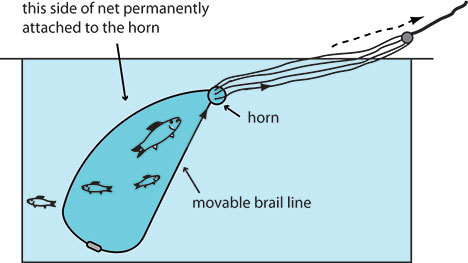
Once the net is landed, the horn is pulled up and the brail lines are drawn back through the horn. This opens the net (the bag disappears) and the fish are able to be removed.
There are many different sizes of cast nets that can be used. When selecting a cast net there are several factors that must be taken into account. You must decide on a mesh size, the weight of the net, the size of the net when opened, and the material the net is made of. The mesh size varies widely for each individual's preference. It depends on what type and size of fish you are targeting.
Cast net suggested uses for mesh sizes:
- 1" - small silver mullet and larger fish.
- 1-1/2" - large silver mullet and larger fish.
- 2" - striped mullet, sheepshead, other large fish.
- 2 - 1/4" - large striped mullet, sheepshead, other large fish.
A cast net with small mesh has more lines intertwined creating more resistance in the water. This type of net will sink slower than a cast net with a larger mesh size providing they weighed the same.
Most of today's cast nets are made of monofilament line. This is the same as the fishing line found on a fishing reel. Monofilament is extremely popular because of its ability to cut through water and sink quickly, while weighing next to nothing. When removed from water, the line is almost instantly dry absorbing practically none of the water.
The best advice is to throw the net in a park until the technique is mastered. It is much harder in real conditions because once the net gets wet it becomes much heavier. You have to be in a good shape to cast a net.

